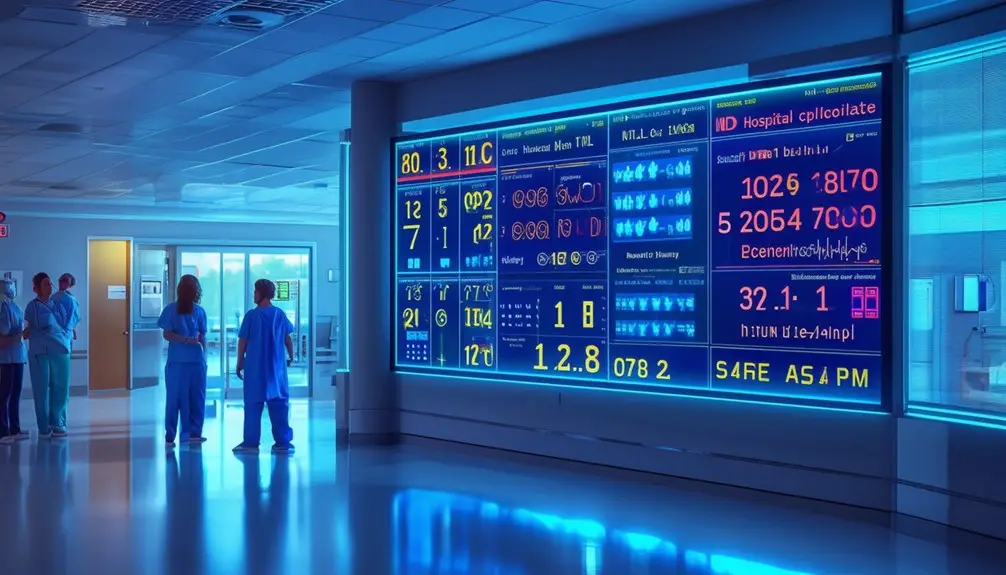Electronic status boards for hospitals revolutionize operations by providing real-time data and improving communication. These boards centralize patient information, streamlining decision-making and reducing errors. Over 50 customizable modules offer tailored patient care management, enhancing efficiency and patient outcomes. Integration with existing systems ensures precise tracking and seamless updates. Real-time alerts and updates boost staff coordination and emergency response times, minimizing delays. Interactive features and automated processes reduce manual workloads, allowing staff to focus more on patient care. Real-time tracking and efficient communication can greatly optimize your hospital’s resource utilization and staff productivity. Discover how this technology can enhance your healthcare delivery.
Key Takeaways
- Real-time updates on patient status improve decision-making and care coordination.
- Over 50 customizable modules offer tailored displays for specific healthcare needs.
- Integration with existing systems ensures efficient data handling and communication.
- Interactive boards enhance staff accountability and operational efficiency.
- Automated alerts and real-time tracking improve emergency response and patient outcomes.
Efficient Patient-Centered Care

HCI Unit Status Boards transform efficient patient-centered care by providing real-time, centralized access to vital medical data, enhancing collaboration among care teams. When you integrate these Interactive Digital whiteboards into your hospital’s workflow, you gain the ability to monitor patient care with unparalleled precision. Real-time updates guarantee that every member of your care team has the most current patient information at their fingertips, enabling faster and more accurate clinical decision-making.
By centralizing patient data, HCI Unit Status Boards eliminate the inefficiencies caused by fragmented information systems. You can see patient vitals, medication schedules, and treatment plans all in one place. This streamlined access supports a more synchronized approach to patient care, reducing the risk of errors and improving overall patient outcomes.
The interactive digital functionalities of these boards foster enhanced communication among multidisciplinary teams. Doctors, nurses, and specialists can easily annotate and update patient information, ensuring that everyone is on the same page. This collaborative environment not only speeds up response times but also ensures that patient care is both thorough and cohesive. By leveraging real-time updates and interactive digital tools, you can elevate the standard of care your hospital provides.
Unit Status Board Configurations
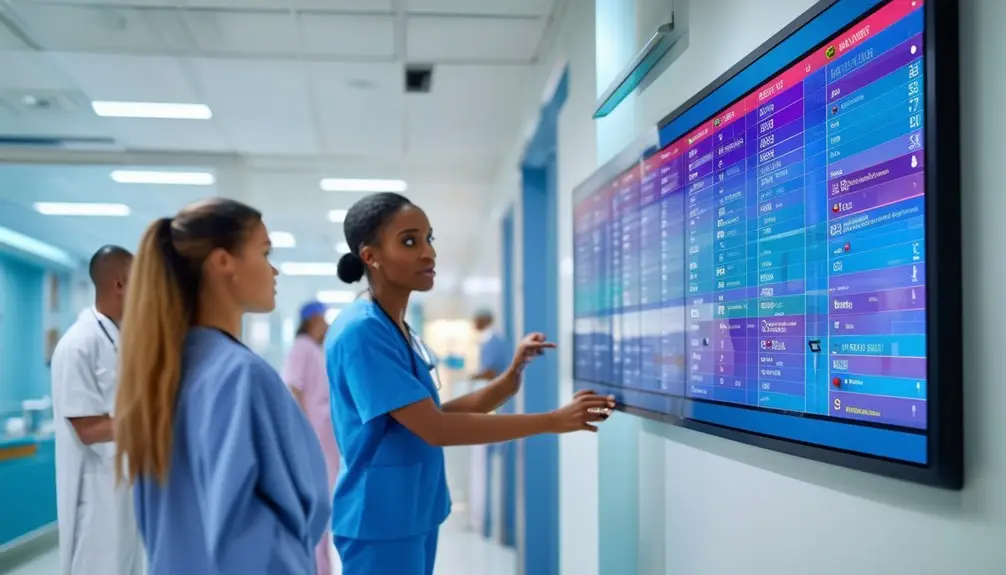
Unit status board configurations offer a versatile array of over 50 customizable modules to meet the specific needs of healthcare organizations. These modules enhance your ability to manage patient status effectively while fostering communication and collaboration among the care team. With options like Home, Services, Infotiles, Room Status Updates, and Care Team modules, you can tailor the system to display real-time patient information that’s vital for informed decision-making.
The Unit Status Board Software is designed for seamless integration with HCI Hardware and leading healthcare TV providers. This compatibility ensures that your staff can access and interact with patient data on interactive digital whiteboards, available in standard TV sizes. This real-time display of patient status not only keeps everyone on the same page but also enhances the overall efficiency of your operations.
Effective communication and collaboration among the care team are essential. The Care Team Module, for instance, provides thorough data access, enabling all team members to stay updated and coordinate care more effectively. By leveraging these customizable modules, you can create a dynamic and responsive environment that greatly improves patient care management.
The HCI Advantage
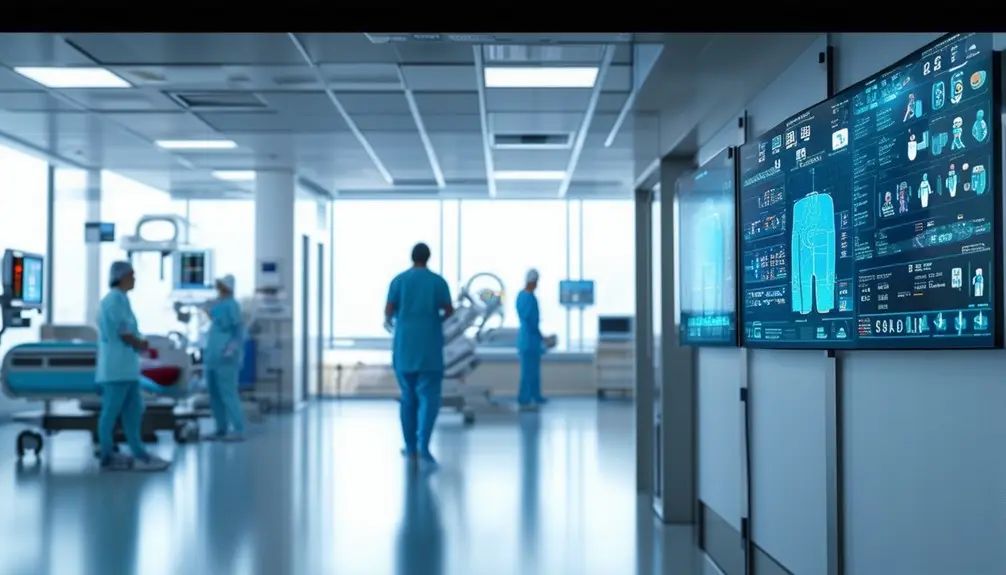
With unparalleled customization and real-time patient data updates, Interactive Unit Status Boards offer healthcare organizations a significant edge in patient care management. These boards guarantee your team receives real-time patient information, improving both workflow and patient outcomes. By integrating seamlessly with your hospital information systems, they offer efficient communication and immediate access to critical patient events.
The real-time alerts and notifications these boards provide enhance patient care by allowing your staff to make informed decisions swiftly. This level of connectivity and constant information flow leads to higher patient satisfaction, as care teams can respond promptly to changing patient conditions.
| Advantage | Benefit |
|---|---|
| Real-time patient updates | Informed decision-making |
| Seamless data integration | Efficient communication |
| Real-time alerts | Enhanced patient care |
These boards display clear and accurate information, ensuring every team member is on the same page. This reduces the likelihood of errors and optimizes workflow, making operations smoother and more efficient. By focusing on both patient satisfaction and operational efficiency, Interactive Unit Status Boards prove to be indispensable tools in modern healthcare settings. Embracing this technology means you’re not just keeping up with the times—you’re setting the standard for exceptional patient care.
Customization and Versatility

You can customize electronic status boards to meet your hospital’s unique needs, offering tailored patient information displays and flexible module configurations. These boards provide real-time updates, enhancing patient management and improving operational efficiency. By integrating with existing systems, they guarantee smooth changes and accurate data handling.
Tailored Patient Information Displays
HCI’s interactive digital whiteboards offer over 50 customizable modules, allowing healthcare organizations to tailor patient information displays to meet their specific needs and enhance operational efficiency. Whether you’re managing a busy hospital ward or a specialized unit, these boards are designed to provide real-time updates and critical alerts, ensuring that care teams are always on the same page. The flexibility of HCI’s system means you can integrate patient information seamlessly with your existing hospital information systems.
You can opt for custom-branded boards that reflect your institution’s identity, similar to what Yale University and Air Liquide have done. The modules available include Home, Services, Infotiles, Room Status Updates, and the Care Team Module. Each module is designed to provide thorough and actionable insights into patient care. For example, the Room Status Updates module instantly informs staff about patient movements and room availability, while the Care Team Module helps track which healthcare professionals are assigned to each patient.
Flexible Module Configurations
Hospitals can leverage the flexible module configurations of HCI’s interactive digital whiteboards to create highly customized and versatile patient information systems. These digital whiteboards come with over 50 customizable modules that are designed to enhance patient care and streamline patient flow. By utilizing these modules, healthcare organizations can effectively manage patient information and guarantee real-time updates are available to the care team.
With HCI’s interactive digital whiteboards, you can:
- Customize Module Layouts: Tailor the display to show only essential information, such as Room Status Updates and Care Team details, to improve workflow efficiency.
- Enhance Patient Communication: Use the Home and Services modules to provide patients with pertinent information and services, contributing to better patient satisfaction.
- Integrate Seamlessly: These boards are compatible with leading healthcare TV providers, ensuring smooth integration into existing systems.
- Personalize Branding: Custom-branded status boards can be created to meet the specific needs of your organization, whether it’s a university hospital or a private healthcare provider.
Efficiency and Monitoring
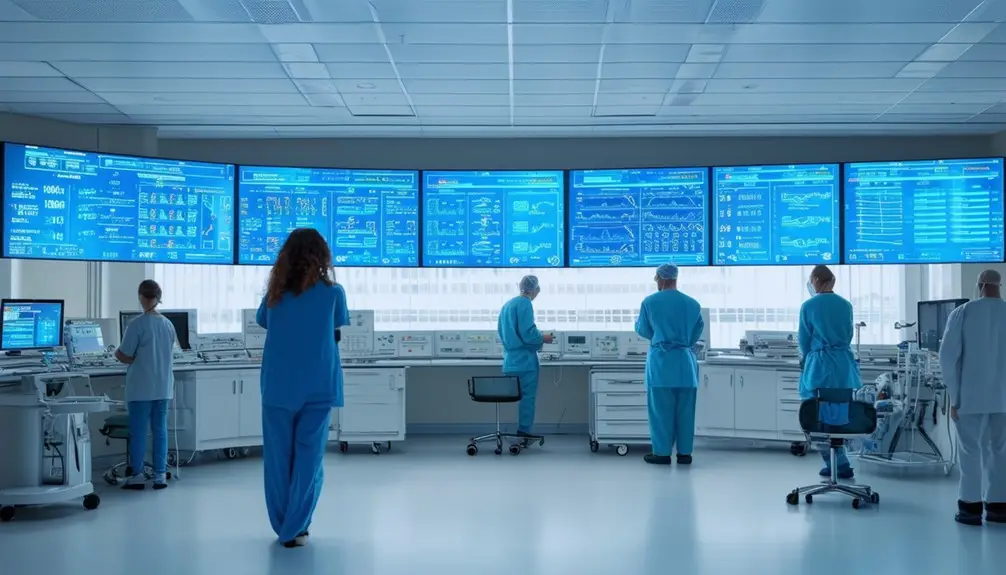
You’ll find that electronic status boards greatly enhance efficiency by providing real-time patient updates, ensuring that your staff stays informed and accountable. With these boards, emergency response times improve as staff can quickly access essential information. Additionally, the ability to monitor staff availability in real-time allows for seamless workflow management and operational control.
Real-Time Patient Updates
Real-time patient updates on electronic status boards significantly enhance communication efficiency and monitoring accuracy within care teams. By providing instant access to patient data, these boards guarantee that everyone is on the same page, minimizing errors and improving patient outcomes. Here’s how real-time updates make a difference:
- Streamlined Patient Data: With real-time updates, patient data is automatically refreshed, guaranteeing that all care teams have access to the most current information.
- Improved Care Coordination: Real-time updates on patient statuses and room availability help care teams coordinate more effectively, reducing downtime and optimizing resource use.
- Timely Interventions: Instant notifications of critical patient events allow care teams to respond promptly, enhancing patient safety and improving outcomes.
- Accurate Monitoring: Real-time tracking of patient progress and care team assignments ensures that every aspect of patient care is monitored accurately, leading to better decision-making.
Staff Accountability Tracking
By leveraging electronic status boards, healthcare facilities can efficiently monitor staff accountability and availability, guaranteeing peak operational efficiency and patient safety. These boards provide real-time updates on employee statuses and locations, which is essential for maintaining high standards in patient care. With instant access to staff information, you can quickly address any staffing gaps or reallocate resources during critical moments, which directly impacts the quality of care patients receive.
Integrating electronic status boards with access control systems is a game-changer. This integration allows for seamless status changes and precise tracking of staff movements. As a result, you get an accurate, up-to-the-minute view of who is available, who is in a procedure, and who is on a break. This ensures that you can make informed decisions swiftly, without the delay associated with traditional methods.
Interactive in/out boards also play a pivotal role in infection control. By knowing exactly who has been in contact with which patients, you can implement targeted measures to prevent the spread of infections. Enhanced communication and collaboration among your team members further streamline operations, ensuring everyone is on the same page.
Emergency Response Efficiency
Electronic status boards greatly boost emergency response efficiency by providing you with real-time updates on muster point statuses and staff locations. These boards are essential in managing chaotic situations where every second counts. By offering precise updates on patient locations and statuses, they help enhance patient care and streamline emergency protocols. Here’s how they can benefit your hospital:
- Real-time Tracking: Keep tabs on staff and patient locations, ensuring that everyone is accounted for and easily reachable during an emergency.
- Enhanced Monitoring: Get updates on patient statuses instantly, allowing for timely interventions and better resource allocation.
- Access Control Integration: Quickly change the status of employees and patients, ensuring seamless compatibility with existing hardware systems.
- Operational Efficiency: Replace traditional methods with interactive in/out boards, providing a quick view of employee availability and improving overall response times.
Integration and Access Control

Integrating electronic status boards with access control systems transforms how hospitals track and update employee statuses in real-time. Digital integration with access control systems allows for instant status changes, making outdated methods a thing of the past. Interactive in/out boards replace traditional tracking methods, ensuring efficient, up-to-date information that’s vital in a fast-paced hospital environment.
Employing seamless integration with various hardware options means these systems are compatible and user-friendly, minimizing the learning curve for hospital staff. This integration enables a quick view of employee statuses, greatly enhancing operational efficiency. For instance, when an employee enters or exits the building, the access control system immediately updates the electronic status board, providing real-time visibility to all relevant parties.
Integrating with access control systems not only enhances communication but also strengthens collaboration among teams. Real-time updates streamline workflows, ensuring that everyone has the most current information available. This immediacy is particularly important in critical situations where knowing the exact status of each team member can impact decision-making and response times.
Communication and Engagement
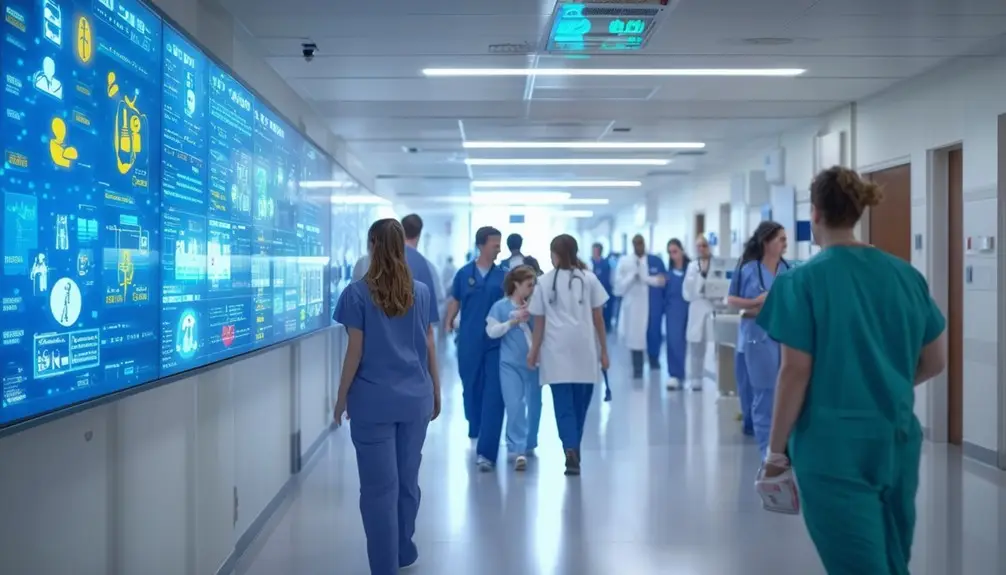
Regularly updated electronic status boards greatly improve communication and engagement among hospital staff by offering real-time information and interactive features. These electronic boards replace traditional methods, providing a modern solution that facilitates quick and efficient status tracking. By displaying real-time updates, they guarantee that everyone is on the same page, reducing misunderstandings and enhancing team coordination.
Using electronic boards, you can access various interfaces such as web-based platforms, mobile applications, and kiosks, making it easier to stay informed wherever you are. Here are some key ways electronic boards enhance communication and engagement:
- Real-time Updates: Immediate access to the latest patient status, bed availability, and other critical information.
- Interactive Features: Ability to input and update information directly, fostering active participation among staff.
- Centralized Communication: Displays contact information, weather updates, and important announcements, ensuring everyone receives the same information simultaneously.
- Accessibility: Multiple interfaces (web, mobile, kiosks) provide flexibility to access information from various devices.
Real-time Care Guidance
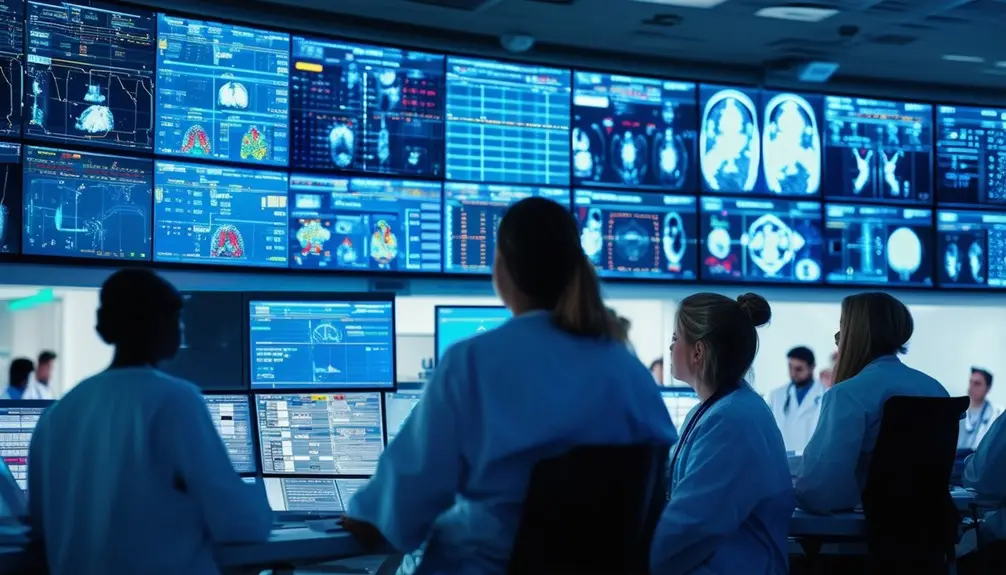
Real-time care guidance enhances patient outcomes by providing caregivers with instant access to up-to-date patient information, ensuring accurate and timely interventions. With digital boards, you can display essential patient information promptly, improving communication between patients and caregivers. This immediacy allows for precise adjustments to care plans, enhancing both the quality of care and patient satisfaction.
Digital boards automatically update patient information in real-time, enabling caregivers to make informed decisions without delay. This reduces the risk of errors and improves the safety of patient care. By leveraging real-time care guidance, you can guarantee that your staff stays informed about each patient’s status, leading to more effective and targeted interventions.
Automated patient updates via digital boards enhance staff efficiency, allowing healthcare providers to allocate more time to direct patient care rather than administrative tasks. This not only increases staff satisfaction scores but also ensures that patients receive the best possible care.
Incorporating real-time care guidance through digital boards guarantees precise and safe data sourcing, ultimately raising the standard of patient care. This seamless integration of technology into daily operations significantly contributes to higher patient satisfaction and improved healthcare outcomes.
Bed Management Challenges
Accurate bed management in hospitals is essential to ensuring peak patient care and operational efficiency. However, hospitals often face significant challenges in tracking inpatients’ locations due to inconsistencies in recording methods. Manual data entry creates hurdles in centralizing and collating information, leading to inefficient management. This can compromise patient outcomes, increase stress on staff, and tarnish the hospital’s reputation.
To tackle these issues, hospitals need to implement robust information systems that offer real-time updates and streamline communication. Here are four key challenges in bed management:
- Inconsistent Recording Methods: Variations in how data is recorded can lead to inaccurate tracking of bed availability and patient location.
- Manual Data Entry: Dependence on manual input makes it difficult to maintain up-to-date and accurate records, hampering decision-making.
- Poor Communication: Inefficient communication channels can delay the relay of essential information, affecting patient care coordination.
- Staff Stress: Inadequate bed management systems increase workload and stress for staff, leading to burnout and reduced effectiveness.
Electronic whiteboarding solutions like MedView Touch address these challenges by providing real-time patient flow management, gender-specific tracking, and automated task checklists, ensuring better communication and efficient use of resources.
Conclusion
Imagine a well-orchestrated symphony, where each note signifies seamless communication and efficiency. With electronic status boards, you’re not just managing data; you’re conducting a masterpiece of real-time, patient-centered care. These boards symbolize the bridge between technology and the human touch, empowering you to deliver precise, timely, and compassionate healthcare. Embrace this digital baton, and watch as your hospital’s operations transform into a harmonious flow of information, guiding every decision with clarity and purpose.
Frequently Asked Questions
What Initial Costs Are Associated With Implementing Electronic Status Boards in Hospitals?
Imagine diving into a sea of initial costs: hardware, software, installation, and training. You’ll need to budget tens of thousands, considering system complexity and integration needs. Prioritize secure, scalable solutions to guarantee long-term efficiency and reliability.
How Do Electronic Status Boards Comply With Patient Privacy Regulations Like Hipaa?
You guarantee electronic status boards comply with HIPAA by incorporating encryption, access controls, and audit trails. Regularly update software and train staff on privacy protocols to prevent unauthorized data access and maintain patient confidentiality.

